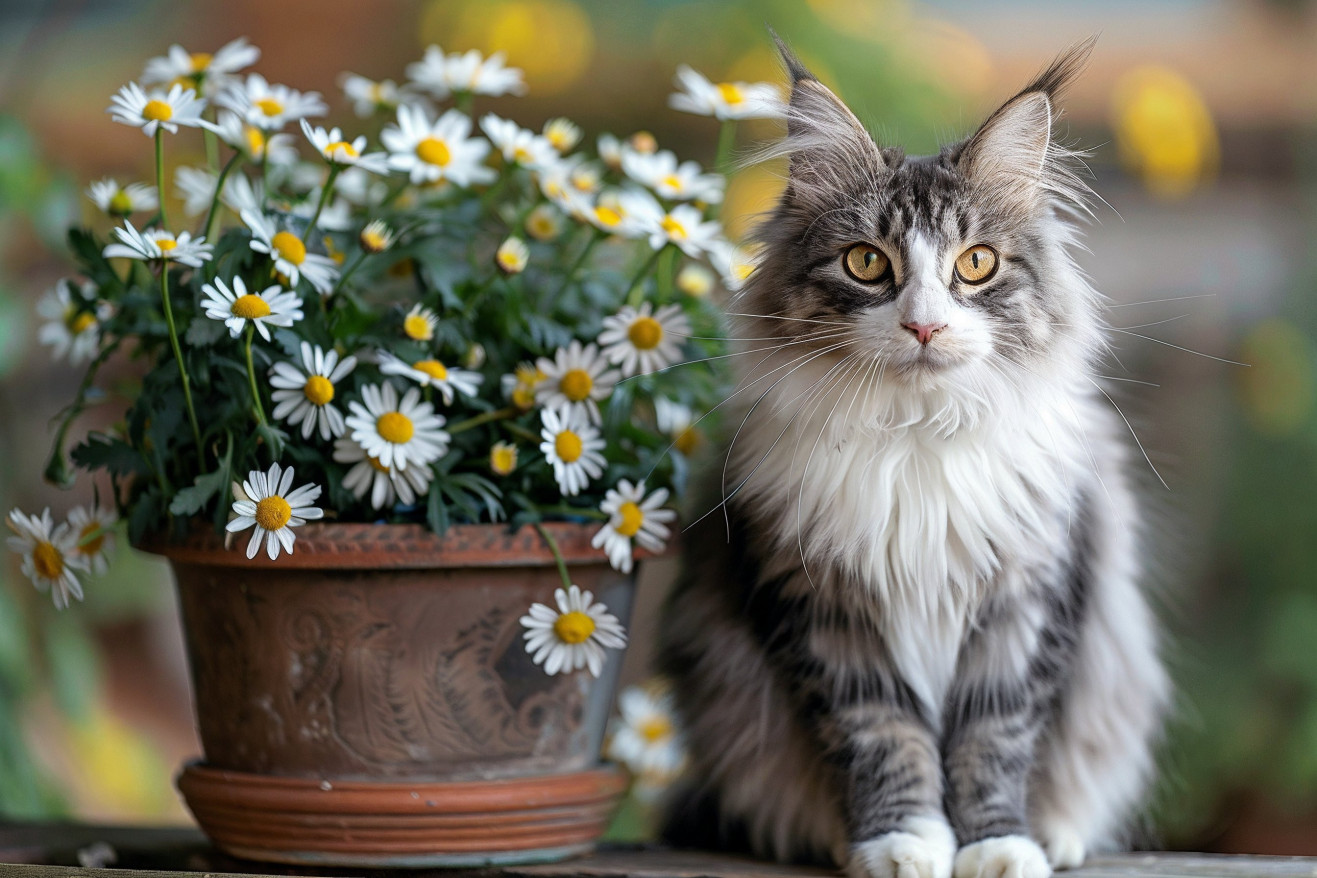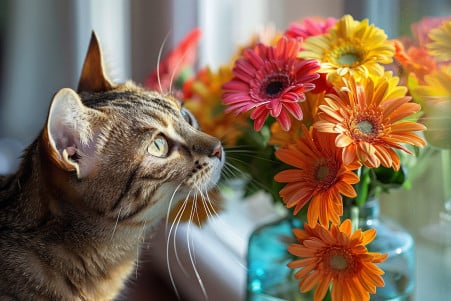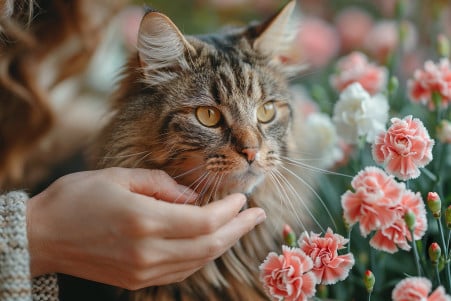Are Daisies Poisonous to Cats? How to Find Safe Plants
18 February 2024 • Updated 18 February 2024

As cat parents look at their gardens, they may wonder if the daisies that are so common are safe for their feline friends. Some daisies have pyrethrin, a natural insecticide that is poisonous to cats and can cause symptoms such as drooling, vomiting, and seizures. That said, not all daisies are toxic. It’s important to know the specific type of daisy to determine if it’s safe to let your cat around them.
In this article, we will take a comprehensive look at daisy toxicity in cats, drawing on a wide range of interdisciplinary research that includes veterinary studies, botanical research, and toxicology case studies. This thorough investigation will walk us through the potential dangers and signs of daisy toxicity in cats.
We will also cover how to prevent it and what to do if your cat is exposed to daisies. By the time you finish reading, you’ll know how to protect your pets from potential plant toxins.
Are daisies poisonous to cats?
The Daisy Dilemma: A Deep Dive into Cat Toxicity
While not all daisies are dangerous to your cat, it is important to know which ones are. According to the ASPCA, plants in the Chrysanthemum family, which is also known as mums, are toxic to cats. These plants have sesquiterpene lactones and the most important toxic component, pyrethrin, which can cause vomiting, diarrhea, hypersalivation, incoordination, and in some cases, dermatitis.
Pyrethrin is a neurotoxin in cats, and it can cause drooling, vomiting, and seizures, according to a study in PMC. Cats are especially susceptible to this toxin because they have a limited ability to metabolize pyrethroids, which are synthetic versions of pyrethrins.
Cat owners can use this information to avoid accidentally poisoning their cats with the wrong daisy. This information is not only important but potentially life-saving because recognizing the symptoms of toxicity can lead to quicker responses and treatments.
Knowing the different types of daisies and how they affect cats is important for understanding the chemical reactions that are happening. This will be explored in more detail below.
Breaking Down the Danger: Pyrethrin Toxicity in Cats
Pyrethrin, a naturally occurring compound in certain daisy species, is highly toxic to cats. Due to its molecular structure, it has a significant impact on the feline nervous system. The Merck Veterinary Manual explains that pyrethrin binds to voltage-gated sodium channels in nerves, causing neurotoxicity that results in muscle tremors, seizures, and hypersalivation. Cats metabolize these compounds more slowly than insects and other mammals, which means they are especially prone to poisoning.
Research published in PMC demonstrates the toxicity of the compound, showing that pyrethrin binds to sodium channels on neurons, inhibits their normal function, and causes repetitive neuronal discharge, which results in serious neurological symptoms. The toxicity can be so extreme that, if the cat isn’t treated immediately, it can cause long-term damage or even death.
Research published in PMC case studies underscores the importance of immediate and effective treatment, including intravenous lipid emulsion therapy, which has been proven to help cats with pyrethrin toxicity recover. This knowledge of chemical dangers is important for pet owners to understand, as it underscores the need for them to be aware and educated about the plants they bring into their homes.
Creating a Safe Space: Daisy Safety for Cat Owners
Cat owners will need to be diligent and make careful plant choices to protect their cats from the dangers of daisies.
As the ASPCA points out, one of the most important steps in preventing daisy poisoning is to make sure you know which plants are safe to bring into your home and garden.
This will help you make sure that you’re only bringing in plants that won’t pose a risk to your cats. This is where resources like the ASPCA’s toxic and non-toxic plant database come in handy, as they can help you tell which plants are safe and which are toxic.
Knowing which plants to look out for is also important in protecting your cat. As The Spruce points out, this will help you make sure that you’re protecting your cat from the potential dangers of the beautiful but toxic plants that you may encounter. You can also help protect your cat by making sure that you keep an eye on them and keep them away from plants that you’re not sure are safe.
If you think your cat has ingested a toxic plant, it’s important to act quickly. As Hill’s Pet explains, it’s important to contact your vet immediately, as this could make a difference in your cat’s chances of survival. With this in mind, cat owners can make sure that their cats can enjoy the beauty of daisies without putting themselves in danger.
How to Handle Daisy Poisoning: What to Do in an Emergency and the Recovery Process
If your cat is showing signs of daisy poisoning, it’s important to act quickly. If you see symptoms like vomiting, diarrhea, or dermatitis as listed by the ASPCA, the first thing you should do is remove any plant material from your cat’s mouth and coat. Then, put your cat in a safe space away from the plant and call your local vet or the Animal Poison Control Center (APCC) immediately.
Veterinarians will typically treat daisy toxicity by decontaminating the cat, which can include inducing vomiting or giving activated charcoal to absorb the toxin, and providing supportive care, which can include giving fluids and medications to help with symptoms like seizures or tremors.
How quickly the cat is treated will have a big impact on their recovery from plant poisoning. Olympia Pet Emergency Center notes that it’s important to give the vet as much information as possible, including the name of the plant that was ingested, so that they can make a more accurate diagnosis and treatment plan. This will help improve the prognosis.
Once a pet has recovered, Cats Protection recommends that pet parents continue to watch for any delayed or long-term effects. It can take time for a pet to fully recover, so pet parents should watch their pet’s behavior and appetite closely to make sure they’re providing the best environment for a full recovery.
The best way to prevent an issue is to be informed and educated, and to take preventative measures to keep our feline friends safe and healthy.
The Broader Context of Plant Toxicity in Pets
Plant toxicity cases are a major issue in veterinary medicine. The Veterinary Toxicology Section of the University of Milan found that plant-related cases made up 5.7 percent of all calls to a poison control center over a 12-year period.
Dogs and cats were the most common victims, and the toxic compounds found in the plants included glycosides, alkaloids, and oxalates. For example, lilies are nephrotoxic to cats and their consumption can result in acute renal failure.
The outcomes of these cases can be anywhere from mild to fatal, which makes it clear that pet owners need to be proactive in protecting their pets.
The rise in popularity of some houseplants may be contributing to the number of cases. This research provides a larger context and further emphasizes the importance of pet owners being aware of potential dangers in their homes.
This is especially important when considering the risks of daisy poisoning in the context of plant toxicity in general, and it shows why pet owners need to be careful when choosing which plants to bring into their homes.
Concluding Thoughts on Daisy Safety for Cats
Our investigation into the safety of daisies for cats has shown that there is a delicate balance between enjoying the beauty of nature and keeping our cats safe. Although some daisy species do contain the toxic compound pyrethrin, part of being a responsible pet owner is knowing which species are safe and recognizing the signs of pyrethrin poisoning, which include vomiting and seizures.
If you think your cat has eaten a toxic plant, it’s important to get them to a vet right away. However, cat owners can also take steps to ensure that their pets are safe by learning which plants are safe and which are toxic and by learning the symptoms of poisoning.
The ASPCA’s list of safe plants is a great place to start for anyone who wants to make sure that the plants they bring into their home are safe for their pets.
In the end, the main takeaway is that knowledge and action are key to being a responsible pet owner. By learning about the potential dangers of plants like daisies, we can make sure that we enjoy our pets and our gardens without worry and that we keep our animal family members safe.


